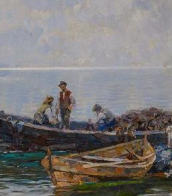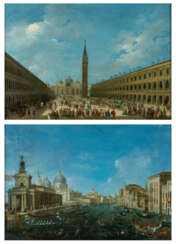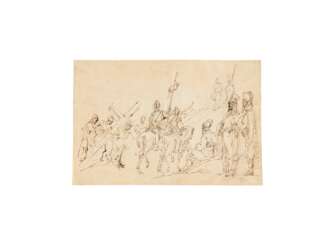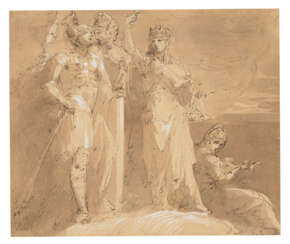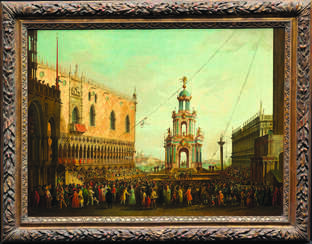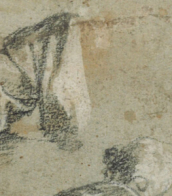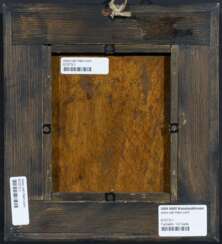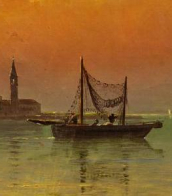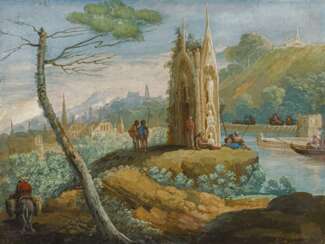giuseppe bernardino bison (1762 - 1844)
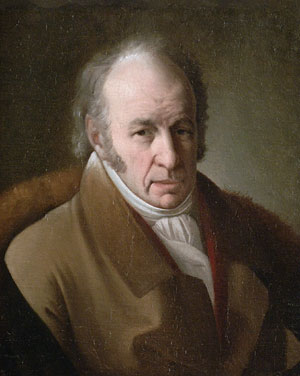
Giuseppe Bernardino Bison was an Italian painter celebrated for his mastery in frescoes, landscapes, vedute, capriccios, and religious works. Bison's journey through art took him across Italy, leaving a legacy that bridged the 18th and 19th centuries. His education under the tutelage of Gerolamo Romani and Constantino Cedini at the Accademia of Venice laid the foundation for a career influenced by the luminaries of Venetian painting, such as Tiepolo and Francesco Guardi.
Bison's eclectic and versatile style made him a pivotal figure in prolonging the vedutist tradition. His oeuvre includes a significant number of graphic works alongside his frescoes and easel paintings, which often depicted topographical vedutas and fantasy scenes. He worked in various cities, including Ferrara, Trieste, and Padua, leaving behind numerous palaces and villas adorned with his frescoes.
His art found a market among the affluent non-aristocrats of the time, collaborating with art dealer Tosoni to produce landscapes and vedute that catered to local tastes. Despite his success in places like Trieste, Bison's later years in Milan were marked by smaller commissions and financial struggles.
Bison's works are preserved in esteemed collections worldwide, including the Cooper Hewitt, Princeton University Art Museum, University of Michigan Museum of Art, Clark Art Institute, Detroit Institute of Arts, and the Metropolitan Museum of Art, among others. His paintings, such as "The Arsenale in Venice," "The Hermits of Thebes," and "Capriccio of Padua," continue to captivate audiences with their intricate detail and historical value.
For collectors and experts in art and antiques, Bison's legacy offers a unique glimpse into the transition of Italian painting from the 18th to the 19th century. His ability to blend realism with fantastical elements makes his work a fascinating study in the evolution of European art.
For updates on exhibitions, sales, and auctions related to Giuseppe Bernardino Bison's works, sign up for our newsletter. Stay informed on the latest discoveries and opportunities to acquire pieces by this remarkable Italian artist.
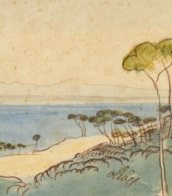

Giuseppe Bernardino Bison was an Italian painter celebrated for his mastery in frescoes, landscapes, vedute, capriccios, and religious works. Bison's journey through art took him across Italy, leaving a legacy that bridged the 18th and 19th centuries. His education under the tutelage of Gerolamo Romani and Constantino Cedini at the Accademia of Venice laid the foundation for a career influenced by the luminaries of Venetian painting, such as Tiepolo and Francesco Guardi.
Bison's eclectic and versatile style made him a pivotal figure in prolonging the vedutist tradition. His oeuvre includes a significant number of graphic works alongside his frescoes and easel paintings, which often depicted topographical vedutas and fantasy scenes. He worked in various cities, including Ferrara, Trieste, and Padua, leaving behind numerous palaces and villas adorned with his frescoes.
His art found a market among the affluent non-aristocrats of the time, collaborating with art dealer Tosoni to produce landscapes and vedute that catered to local tastes. Despite his success in places like Trieste, Bison's later years in Milan were marked by smaller commissions and financial struggles.
Bison's works are preserved in esteemed collections worldwide, including the Cooper Hewitt, Princeton University Art Museum, University of Michigan Museum of Art, Clark Art Institute, Detroit Institute of Arts, and the Metropolitan Museum of Art, among others. His paintings, such as "The Arsenale in Venice," "The Hermits of Thebes," and "Capriccio of Padua," continue to captivate audiences with their intricate detail and historical value.
For collectors and experts in art and antiques, Bison's legacy offers a unique glimpse into the transition of Italian painting from the 18th to the 19th century. His ability to blend realism with fantastical elements makes his work a fascinating study in the evolution of European art.
For updates on exhibitions, sales, and auctions related to Giuseppe Bernardino Bison's works, sign up for our newsletter. Stay informed on the latest discoveries and opportunities to acquire pieces by this remarkable Italian artist.


Giuseppe Bernardino Bison was an Italian painter celebrated for his mastery in frescoes, landscapes, vedute, capriccios, and religious works. Bison's journey through art took him across Italy, leaving a legacy that bridged the 18th and 19th centuries. His education under the tutelage of Gerolamo Romani and Constantino Cedini at the Accademia of Venice laid the foundation for a career influenced by the luminaries of Venetian painting, such as Tiepolo and Francesco Guardi.
Bison's eclectic and versatile style made him a pivotal figure in prolonging the vedutist tradition. His oeuvre includes a significant number of graphic works alongside his frescoes and easel paintings, which often depicted topographical vedutas and fantasy scenes. He worked in various cities, including Ferrara, Trieste, and Padua, leaving behind numerous palaces and villas adorned with his frescoes.
His art found a market among the affluent non-aristocrats of the time, collaborating with art dealer Tosoni to produce landscapes and vedute that catered to local tastes. Despite his success in places like Trieste, Bison's later years in Milan were marked by smaller commissions and financial struggles.
Bison's works are preserved in esteemed collections worldwide, including the Cooper Hewitt, Princeton University Art Museum, University of Michigan Museum of Art, Clark Art Institute, Detroit Institute of Arts, and the Metropolitan Museum of Art, among others. His paintings, such as "The Arsenale in Venice," "The Hermits of Thebes," and "Capriccio of Padua," continue to captivate audiences with their intricate detail and historical value.
For collectors and experts in art and antiques, Bison's legacy offers a unique glimpse into the transition of Italian painting from the 18th to the 19th century. His ability to blend realism with fantastical elements makes his work a fascinating study in the evolution of European art.
For updates on exhibitions, sales, and auctions related to Giuseppe Bernardino Bison's works, sign up for our newsletter. Stay informed on the latest discoveries and opportunities to acquire pieces by this remarkable Italian artist.


Giuseppe Bernardino Bison was an Italian painter celebrated for his mastery in frescoes, landscapes, vedute, capriccios, and religious works. Bison's journey through art took him across Italy, leaving a legacy that bridged the 18th and 19th centuries. His education under the tutelage of Gerolamo Romani and Constantino Cedini at the Accademia of Venice laid the foundation for a career influenced by the luminaries of Venetian painting, such as Tiepolo and Francesco Guardi.
Bison's eclectic and versatile style made him a pivotal figure in prolonging the vedutist tradition. His oeuvre includes a significant number of graphic works alongside his frescoes and easel paintings, which often depicted topographical vedutas and fantasy scenes. He worked in various cities, including Ferrara, Trieste, and Padua, leaving behind numerous palaces and villas adorned with his frescoes.
His art found a market among the affluent non-aristocrats of the time, collaborating with art dealer Tosoni to produce landscapes and vedute that catered to local tastes. Despite his success in places like Trieste, Bison's later years in Milan were marked by smaller commissions and financial struggles.
Bison's works are preserved in esteemed collections worldwide, including the Cooper Hewitt, Princeton University Art Museum, University of Michigan Museum of Art, Clark Art Institute, Detroit Institute of Arts, and the Metropolitan Museum of Art, among others. His paintings, such as "The Arsenale in Venice," "The Hermits of Thebes," and "Capriccio of Padua," continue to captivate audiences with their intricate detail and historical value.
For collectors and experts in art and antiques, Bison's legacy offers a unique glimpse into the transition of Italian painting from the 18th to the 19th century. His ability to blend realism with fantastical elements makes his work a fascinating study in the evolution of European art.
For updates on exhibitions, sales, and auctions related to Giuseppe Bernardino Bison's works, sign up for our newsletter. Stay informed on the latest discoveries and opportunities to acquire pieces by this remarkable Italian artist.
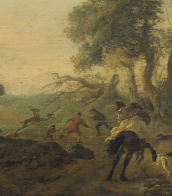

Giuseppe Bernardino Bison was an Italian painter celebrated for his mastery in frescoes, landscapes, vedute, capriccios, and religious works. Bison's journey through art took him across Italy, leaving a legacy that bridged the 18th and 19th centuries. His education under the tutelage of Gerolamo Romani and Constantino Cedini at the Accademia of Venice laid the foundation for a career influenced by the luminaries of Venetian painting, such as Tiepolo and Francesco Guardi.
Bison's eclectic and versatile style made him a pivotal figure in prolonging the vedutist tradition. His oeuvre includes a significant number of graphic works alongside his frescoes and easel paintings, which often depicted topographical vedutas and fantasy scenes. He worked in various cities, including Ferrara, Trieste, and Padua, leaving behind numerous palaces and villas adorned with his frescoes.
His art found a market among the affluent non-aristocrats of the time, collaborating with art dealer Tosoni to produce landscapes and vedute that catered to local tastes. Despite his success in places like Trieste, Bison's later years in Milan were marked by smaller commissions and financial struggles.
Bison's works are preserved in esteemed collections worldwide, including the Cooper Hewitt, Princeton University Art Museum, University of Michigan Museum of Art, Clark Art Institute, Detroit Institute of Arts, and the Metropolitan Museum of Art, among others. His paintings, such as "The Arsenale in Venice," "The Hermits of Thebes," and "Capriccio of Padua," continue to captivate audiences with their intricate detail and historical value.
For collectors and experts in art and antiques, Bison's legacy offers a unique glimpse into the transition of Italian painting from the 18th to the 19th century. His ability to blend realism with fantastical elements makes his work a fascinating study in the evolution of European art.
For updates on exhibitions, sales, and auctions related to Giuseppe Bernardino Bison's works, sign up for our newsletter. Stay informed on the latest discoveries and opportunities to acquire pieces by this remarkable Italian artist.
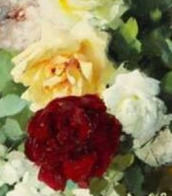

Giuseppe Bernardino Bison was an Italian painter celebrated for his mastery in frescoes, landscapes, vedute, capriccios, and religious works. Bison's journey through art took him across Italy, leaving a legacy that bridged the 18th and 19th centuries. His education under the tutelage of Gerolamo Romani and Constantino Cedini at the Accademia of Venice laid the foundation for a career influenced by the luminaries of Venetian painting, such as Tiepolo and Francesco Guardi.
Bison's eclectic and versatile style made him a pivotal figure in prolonging the vedutist tradition. His oeuvre includes a significant number of graphic works alongside his frescoes and easel paintings, which often depicted topographical vedutas and fantasy scenes. He worked in various cities, including Ferrara, Trieste, and Padua, leaving behind numerous palaces and villas adorned with his frescoes.
His art found a market among the affluent non-aristocrats of the time, collaborating with art dealer Tosoni to produce landscapes and vedute that catered to local tastes. Despite his success in places like Trieste, Bison's later years in Milan were marked by smaller commissions and financial struggles.
Bison's works are preserved in esteemed collections worldwide, including the Cooper Hewitt, Princeton University Art Museum, University of Michigan Museum of Art, Clark Art Institute, Detroit Institute of Arts, and the Metropolitan Museum of Art, among others. His paintings, such as "The Arsenale in Venice," "The Hermits of Thebes," and "Capriccio of Padua," continue to captivate audiences with their intricate detail and historical value.
For collectors and experts in art and antiques, Bison's legacy offers a unique glimpse into the transition of Italian painting from the 18th to the 19th century. His ability to blend realism with fantastical elements makes his work a fascinating study in the evolution of European art.
For updates on exhibitions, sales, and auctions related to Giuseppe Bernardino Bison's works, sign up for our newsletter. Stay informed on the latest discoveries and opportunities to acquire pieces by this remarkable Italian artist.
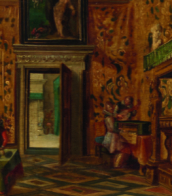

Giuseppe Bernardino Bison was an Italian painter celebrated for his mastery in frescoes, landscapes, vedute, capriccios, and religious works. Bison's journey through art took him across Italy, leaving a legacy that bridged the 18th and 19th centuries. His education under the tutelage of Gerolamo Romani and Constantino Cedini at the Accademia of Venice laid the foundation for a career influenced by the luminaries of Venetian painting, such as Tiepolo and Francesco Guardi.
Bison's eclectic and versatile style made him a pivotal figure in prolonging the vedutist tradition. His oeuvre includes a significant number of graphic works alongside his frescoes and easel paintings, which often depicted topographical vedutas and fantasy scenes. He worked in various cities, including Ferrara, Trieste, and Padua, leaving behind numerous palaces and villas adorned with his frescoes.
His art found a market among the affluent non-aristocrats of the time, collaborating with art dealer Tosoni to produce landscapes and vedute that catered to local tastes. Despite his success in places like Trieste, Bison's later years in Milan were marked by smaller commissions and financial struggles.
Bison's works are preserved in esteemed collections worldwide, including the Cooper Hewitt, Princeton University Art Museum, University of Michigan Museum of Art, Clark Art Institute, Detroit Institute of Arts, and the Metropolitan Museum of Art, among others. His paintings, such as "The Arsenale in Venice," "The Hermits of Thebes," and "Capriccio of Padua," continue to captivate audiences with their intricate detail and historical value.
For collectors and experts in art and antiques, Bison's legacy offers a unique glimpse into the transition of Italian painting from the 18th to the 19th century. His ability to blend realism with fantastical elements makes his work a fascinating study in the evolution of European art.
For updates on exhibitions, sales, and auctions related to Giuseppe Bernardino Bison's works, sign up for our newsletter. Stay informed on the latest discoveries and opportunities to acquire pieces by this remarkable Italian artist.
